Perfectly positioned in the southern area of the Kruger National Park, Jock Safari Lodge rests at the confluence of the Mitomeni and Biyamiti rivers. This 6, 000ha exclusive concession is situated half way between Skukuza and the Malelane Gate. Jock Safari Lodge is named after a local legend, Jock of the Bushveld, a true animal classic book written during South Africa’s first gold rush era.
Jock Safari Lodge was the very first privately owned and operated concession in the Kruger National Park, placed within the 6, 000 ha of pristine bushveld, Jock has exclusive traversing rights in what is regarded as the best Big Five game viewing area in the Kruger.
It’s Jock’s unique location within the Kruger National Park that allow the sightings to be more frequent by comparison to other areas. Jock sits in the original heart of the KNP, the wildlife within this region have survived undisturbed without any negative impact from mankind. It’s an area of unbroken landscape where the wildlife have always been encouraged to thrive, it also gives credit as to why we are so fortunate to encounter so many other endangered species within the concession such as: wild dog, cheetah and ground hornbill.
Together with SANParks, the National conservation authorities, the Caleo Foundation and Jock wildlife Ranger team, we strive to support the conservation of this land, ensuring it will be enjoyed for future generations to come.
Rare and Endangered Cheetah
There are fewer than 200 cheetah in the Kruger National Park. That makes them the rarest of the big cats and a very rare sighting indeed while on safari. Despite their numbers the rangers still see cheetah in the Jock area at least once a week. There is a well-known coalition of three males that regularly moves through the area and a few females that have cubs at regular intervals. It’s Jock’s unique location within the Kruger National Park that sets it apart, placed in the heart of the original KNP, the wildlife within this region have survived undisturbed with no negative impact from mankind. It’s an area of unbroken landscape where the wildlife have always been encouraged to thrive.
Birds
There are a staggering estimated 500 species of bird in The Kruger National Park.
Although a large percentage of birds seen in the Kruger National Park are summer visitors, many are resident and can be viewed all year round. The Biyamiti Weir is the best place in the park to see numerous water birds, such as storks and egrets, which are mesmerising to watch as they chase after frogs and fish.
At night, it’s not uncommon to see and hear owls. The resident barn, barred and giant eagle owls are the ones to look out for as they aren’t often seen outside protected areas.
Reptiles, Frogs and Fish
Home to 60 species of reptile, about 40 species of frog and a variety of fish. The creatures that occur in a particular landscape do so for special reasons resulting from a combination of climate, geology, soils and vegetation. The reptiles, frogs and fish on the Jock Concession are no different, the landscape in which they occur provide a unique set of conditions for a habitat in which to thrive.
The habitat in the Jock landscape is ideal for more than 40 species of frog, none more impressive than the African bullfrog, which breeds in rain-filled pools in summer. Other common residents include the arboreal foam nest frog, whose foam-like nests are constructed over freestanding pools. While there are many reptiles to see certain ones tend to require more respect and gain more attention than others, such as the Black Mamba which can be found in all types of habitat in the African savanna. Characteristically, the head is coffin shaped, with a black mouth interior.
Most of the fish that are found in the concession migrate upstream from the Crocodile River into the Biyamiti River and other tributaries. The long-finned eel inhabits larger bodies of open water, particularly deeper pools with a rocky bottom or with plenty of cover in the form of aquatic vegetation. Eels appear to feed mainly at night, with younger ones seeking out midges and mayfly larvae while larger ones feed on crabs, fish and frogs.
Remarkable Trees
Trees form an important part of the ecosystem, providing food from their leaves, fruit, bark and roots as well as shade in the hot summer heat. Certain mammal and bird species would not exist without trees – one of them being the ground hornbill. It makes its nest in the giant jackalberry, for example, the tree into which leopards also drag their kill, high out of the reach of scavenging hyena.
The Jock concession adorns numerous protected trees species such as the Leadwood tree, previously plundered for its excellent firewood qualities now more practically used as nesting areas for larger bird species such as eagles.
The incredible mammal and bird species that visitors see during a safari at Jock may take centre stage, but few people leave without being in awe of the magnificent trees that adorn its river banks and granite rocky outcrops.

